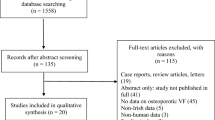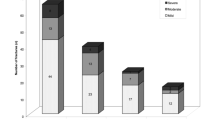Abstract
Justification Criteria for Vertebral Fractures 2012 version was made based on new clinical findings. Major differences in this version compared to the 1996 version are inclusion of the semiquantitative method (SQ), statements to improve considerations during radiographic analysis, and the need for more detailed evaluation by MRI.
Similar content being viewed by others
Avoid common mistakes on your manuscript.
Introduction
Justification Criteria for Vertebral Fractures was published in 1996 by the Japanese Society for Bone and Mineral Research for inclusion in Diagnostic Criteria for Primary Osteoporosis [1]. The new 2012 version was made based on new clinical findings in order to consider usefulness in daily clinical practice from the view points of treatment of osteoporosis and vertebral fractures.
Concerns about justification criteria for vertebral fractures (1996)
Details for Justification Criteria for Vertebral Fractures (1996) are presented in Table 1. There was some concern about this version described as follows:
-
1.
Quantitative measurement (QM) was almost never used in daily clinical practice or epidemiological surveys except in some clinical trials [2] since values measured by QM were likely to be influenced by the patient’s positioning during X-ray. Also, it takes time to measure results;
-
2.
Vertebral fractures could have been diagnosed even if no morphometrical changes were observable.
New justification criteria for vertebral fractures (2012, revised version)
The Committee for Vertebral Fracture Evaluation discussed these issues concerning the 1996 version and made new recommendations for the 2012 version shown in Table 2.
Diagnosis of vertebral fractures is made in two clinical fields—osteoporosis treatment and fracture treatment; it would make sense to use the same criteria for vertebral fractures in both fields. Major differences in the 2012 version compared to the 1996 version are as follows:
-
1.
Inclusion of the semiquantitative method (SQ) SQ was developed by Genant in 1994 and has been used widely in epidemiological surveys and clinical trials [3]. Since SQ is simpler and more easily analyzable than QM, which requires measurements of vertebral heights, it allows great promise in clinical practice [4, 5]. In this revision for 2012, SQ is included in addition to QM.
-
2.
Statements were added to improve considerations during radiographic analysis, specifically the three-dimensional structure of vertebra when reading radiographs Since radiographic lines on endplates appear different according to the incidence angle of the X-ray, careful attention should be paid to the measurement of vertebral heights [6]. In addition, deformities caused by influences other than osteoporosis might exist. These points cannot be overemphasized when reading radiographs.
-
3.
The need for more detailed evaluation by MRI It is important to diagnose carefully vertebral fractures in the diagnosis and treatment of osteoporosis as well as evaluation toward effective treatment. However, fractures with no vertebral deformities must still be managed for fracture repair. MRI is useful in the diagnosis of symptomatic fresh vertebral fractures with no deformities and for judging whether the fracture is of the fresh or old type [7–9]. The following description was added: a vertebral fracture can be diagnosed when low intensity in T1 weighted MRI sagittal views limited within the vertebral body was observed (the same area should also show high intensity in STIR).
References
Orimo H, Sugioka Y, Fukunaga H, et al (1997) Diagnostic criteria for primary osteoporosis: year 1996 revision. Nihon Kotsutaisha Gakkai Zasshi 14:219–233
Chestnut MC, Ross PD, Christiansen C et al (2004) Effects of oral ibandronate administrated daily or intermittently on fracture risk in postmenopausal osteoporosis. J Bone Miner Res 19:1241–1249
Genant HK, Wu CY, vanKuijk C et al (1993) Vertebral fracture assessment using a semiquantitative technique. J Bone Miner Res 8:1137–1148
Ettinger B, Black DM, Mitlak BH et al (1999) Reduction of vertebral fracture risk in postmenopausal women with osteoporosis treated with raloxifene: multiple outcomes of raloxifene evaluation (MORE) investigators. JAMA 282:637–664
Neer RM, Amaud CD, Zaruchetta JR et al (2001) Effects of parathyroid hormone (1–34) on fractures and bone mineral density in postmenopausal women with osteoporosis. N Engl J Med 344:1433–1441
Yamamoto K, Inoue T, Takahashi H et al (1995) Criteria of pointing and ruled line for measurement of vertebral deformities on X-ray. Orthopedic Surgery 46:5–17
Nakano T, Inaba D, Takada K et al. (2003) Osteoporos Jpn 11:747–750 (in Japanese)
Kato Y, Kaneya K, Wada K et al (2009) Magnetic resonance imaging follow-up study in the evaluation of vertebral fractures in osteoporotic patients-randomized control clinical study. Osteoporos Jpn 17:218–221
Japanese 2011 Guideline for Prevention and Treatment of Osteoporosis. Tokyo: Life Science Publishing; 2011
Conflict of interest
None.
Author information
Authors and Affiliations
Consortia
Corresponding author
Additional information
Satoshi Mori (Chair of the Committee for Vertebral Fracture Evaluation), Saeko Fujiwara, Yoshiharu Kato, and Naoto Endo (Advisor) are affiliated to Japanese Society for Bone Morphometry, Satoshi Soen and Hiroshi Hagino to Japanese Society for Bone and Mineral Research, Tetsuo Nakano to Japan Osteoporosis Society, Masako Ito to Japan Osteoporosis Society and Japan Radiological Society, Yasuaki Tokuhashi to Japanese Orthopaedic Association, Daisuke Togawa to Japanese Society for Spine Surgery and Related Research, and Takeshi Sawaguchi (Observer) to Japanese Society for Fracture Repair.
About this article
Cite this article
Mori, S., Soen, S., Hagino, H. et al. Justification criteria for vertebral fractures: year 2012 revision. J Bone Miner Metab 31, 258–261 (2013). https://doi.org/10.1007/s00774-013-0441-1
Received:
Accepted:
Published:
Issue Date:
DOI: https://doi.org/10.1007/s00774-013-0441-1






